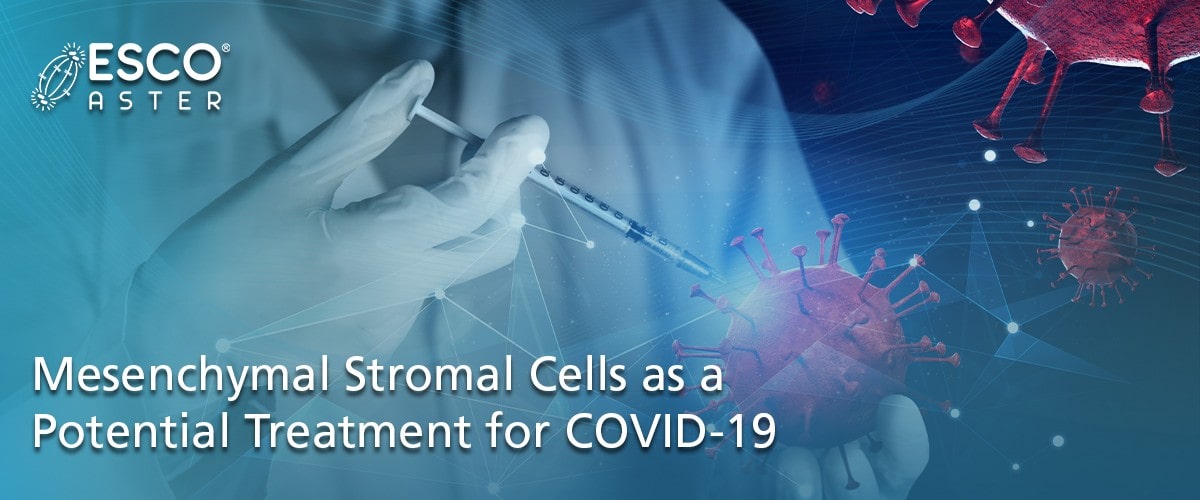
The COVID-19 pandemic ravages healthcare systems globally, giving impetus for research institutes around the world to explore clinical solutions to aid recovery and reduce the mortality rate of infected individuals. The accelerated recovery of patients in critical condition will alleviate heavily overtaxed healthcare systems, freeing up resources to better combat the pandemic and allow hospitals to better maintain standard operational capacity of treatment.
The COVID-19 mechanism
In severe cases of COVID-19 infection, damage to the alveolar epithelial cells from viral infection and immunological injury often leads to the onset of Acute Respiratory Distress Syndrome (ARDS) [1, 2]. When suffering from ARDS, a patient’s body produces large amounts of inflammatory cytokines and immune cells [3], further causing damage to respiratory tissue and resulting in severe hypoxemia [4]. ARDS is the primary condition leading to death especially when combined with other comorbidities such as hypertension and diabetes [5, 6]. Mortality of ARDS from critical care COVID-19 patients ranged from 26% to 61.5% and 65.7% to 94% in patients who had received mechanical ventilation [2]. As such, therapeutic solutions targeting ARDS and its associated effects will aid in the recovery and reduction of mortality rates of COVID-19 patients.
Mesenchymal Stromal Cells and their effect on COVID-19
Studies have found the therapeutic strengths of Mesenchymal Stromal Cells (MSCs) to be of their secretome rather than their multipotent differentiation capabilities [7]. The shift in focus of MSC therapy has led to discoveries that the MSC secretome, which include cytokines and extracellular vesicles, possess immunomodulatory properties and can be effectively used in the treatment of several diseases such as Graft versus Host Disease and traditional ARDS [8, 9]. This immunomodulatory effect could be extended to the treatment of inflammation and the recovery of damaged alveolar tissue from ARDS caused by COVID-19 infection.
In addition to the immunomodulatory effect of MSCs, MSCs also possess anti-microbial properties via production of antimicrobial peptides and proteins which disrupt membrane integrity by inhibiting bacterial protein, DNA and RNA synthesis [10]. This suggests MSC therapy, will have a secondary effect of enhancing the body’s immune response to bacterial secondary infection [10].
The enhancement of alveolar fluid clearance by expediting the transport of fluid across alveolar epithelial cells in damaged alveolar tissue is another beneficial secondary effect MSCs can exert in lungs from mediation via FGF7 [11], further accelerating patient recovery through the normalisation of alveolar fluid clearance.
Upscaling MSC production with Bioreactors
With the potential use of MSCs in COVID-19 treatment, production scale will need to meet the demand for ample quantities of MSCs to be used in widespread treatment of patients. 3-dimensional packed bed culture has emerged to be a cost effective and convenient cell expansion tool, whilst still retaining traditional culture media demands. ESCO ASTER provides a range of 3-dimensional bioreactors for convenient, linearly scalable expansion of adherent cells. When expanding Roosterbio Adipose derived MSCs in the Celcradle™, 6 cell population doublings were obtained at the rate of 600,000 cells per millilitre of media. To find out more about the benefits of 3-dimensional culture systems check out Mayasari Lim’s article.
Esco Aster will be participating in the ISCT Virtual Annual Meeting on 26- 28 this month of May, 2021.
Register at https://isct2021.com/access-and-registration/ today!
TideXcell®
The TideXcell® bioreactor system is the extended large scale system of the lab scale CelCradle™ bioreactor system. In this system, a matrix vessel is packed with macroporous BioNOC™ II carriers and functions as an artificial lung with huge contact surface for nutrition and aeration.
References
[1] X. Li and X. Ma, “Acute respiratory failure in COVID-19: is it ‘typical’ ARDS?,” Critical Care, vol. 24, no. 1, Jun. 2020.
[2] P. G. Gibson, L. G. Qin, and S. G. Puah, “COVID-19 ARDS: clinical features and differences to ‘usual’ pre-COVID ARDS,” Medical Journal of Australia, Preprints, Apr. 2020.
[3] P. Mehta, D. F. Mcauley, M. Brown, E. Sanchez, R. S. Tattersall, and J. J. Manson, “COVID-19: consider cytokine storm syndromes and immunosuppression,” The Lancet, vol. 395, no. 10229, pp. 1033–1034, 2020.
[4] G. D. Rubenfeld, A. S. Slutsky, B. T. Thompson, and For The Ards Definition Task Force, “Definition of Acute Respiratory Distress Syndrome—Reply,” Jama, vol. 308, no. 13, p. 1321, Mar. 2012.
[5] J. Xie, Z. Tong, X. Guan, B. Du, and H. Qiu, “Clinical Characteristics of Patients Who Died of Coronavirus Disease 2019 in China,” JAMA Network Open, vol. 3, no. 4, Oct. 2020.
[6] F. Zhou, T. Yu, R. Du, G. Fan, Y. Liu, Z. Liu, J. Xiang, Y. Wang, B. Song, X. Gu, L. Guan, Y. Wei, H. Li, X. Wu, J. Xu, S. Tu, Y. Zhang, H. Chen, and B. Cao, “Clinical course and risk factors for mortality of adult inpatients with COVID-19 in Wuhan, China: a retrospective cohort study,” The Lancet, vol. 395, no. 10229, pp. 1054–1062, 2020.
[7] J. L. Spees, R. H. Lee, and C. A. Gregory, “Mechanisms of mesenchymal stem/stromal cell function,” Stem Cell Research & Therapy, vol. 7, no. 1, 2016.
[8] J.-W. Lee, P. R. Rocco, and P. Pelosi, “Mesenchymal Stem Cell Therapy for Acute Respiratory Distress Syndrome,” Anesthesiology, vol. 122, no. 2, pp. 238–240, 2015.
[9] M. A. Matthay, “Therapeutic Potential of Mesenchymal Stromal Cells for Acute Respiratory Distress Syndrome,” Annals of the American Thoracic Society, vol. 12, no. Supplement 1, 2015.
[10] F. Alcayaga-Miranda, J. Cuenca, and M. Khoury, “Antimicrobial Activity of Mesenchymal Stem Cells: Current Status and New Perspectives of Antimicrobial Peptide-Based Therapies,” Frontiers in Immunology, vol. 8, 2017.
[11] M. A. Matthay and R. L. Zemans, “The Acute Respiratory Distress Syndrome: Pathogenesis and Treatment,” Annual Review of Pathology: Mechanisms of Disease, vol. 6, no. 1, pp. 147–163, 2011.